
John Henry Want QC (4 May 1846 – 22 November 1905) [1] was an Australian barrister and politician, as well as the 19th Attorney-General of New South Wales.

John Henry Want QC (4 May 1846 – 22 November 1905) [1] was an Australian barrister and politician, as well as the 19th Attorney-General of New South Wales.
Want was born at the Glebe, Sydney, the fourth son of nine children of Randolph John Want, a solicitor, and his wife, Hariette, née Lister. [1] [2] Want was educated at Rev. W. H. Savigny's Collegiate School, Cooks River, and reportedly in Caen, Normandy, France, [1] where he learned to speak fluent French. Want worked in his father's office but soon became bored with the legal practice, went on the land in Queensland, and afterward worked in a mine at Lithgow. [1] Want then returned to Sydney and read in the chambers of Sir Frederick Darley. [1] Want was called to the bar on 13 November 1869 [1] and established a large practice as a barrister. [3] He also engaged in many profitable commercial ventures, some of a "suspicious character". [4]
Want was a keen yachtsman, his father had been a founding member of the Royal Sydney Yacht Squadron in 1862, and in 1883 Want travelled to England to look for a new vessel. He purchased the Mignonette at Cowes, a 19.43 net tonnage, 52 foot cruiser built in 1867. [5] The yacht could only reasonably be transported to Australia by sailing her there but she was a small vessel and the prospect of a 15,000 mile voyage hampered Want's initial attempts to find a suitable crew. However, she finally set sail for Sydney from Southampton on 19 May 1884 with a crew of four: Tom Dudley, the captain; Edwin Stephens; Edmund Brooks; and Richard Parker, the cabin boy. Parker was aged 17 and an inexperienced seaman. [6]
On 5 July, the yacht was running before a gale at 27°10' south, 9°50' west, around 1,600 miles northwest of the Cape of Good Hope. Though the weather was by no means extreme and the vessel was not in any difficulties, a wave struck the yacht and washed away the lee bulwarks. Dudley instantly realised that the yacht was doomed and ordered the single 13-foot lifeboat to be lowered. The Mignonette sank within five minutes of being struck and the crew abandoned ship for the lifeboat, only managing to salvage vital navigational instruments along with two tins of turnips and no fresh water. [7] There have been various theories about the structural inadequacies of the yacht that led to such a catastrophic failure in routine weather. [8]
The crew were adrift for 24 days and resorted to cannibalism, with Parker being killed and eaten and Dudley and Stephens later prosecuted in England in a landmark case.
Want was a candidate for the New South Wales Legislative Assembly seat of Gundagai at the 1884 by-election, but was unsuccessful. [9] Want was successful at the 1885 election, [10] His parliamentary skills were recognised and he became Attorney-General in the first ministry of George Dibbs (October to December 1885) and in the Patrick Jennings ministry (February 1886 to January 1887). [11]
He was a staunch free-trader and with the emergence of political parties in 1887 could not continue to work with Dibbs and Jennings who had formed the Protectionist Party, but neither could he work under Henry Parkes who led the bulk of free traders. [12] Want stood as an independent free trade candidate at the 1887 election where he was re-elected. [13] For a while he formed a small corner party which he facetiously referred to as "the home for lost dogs". [3]
In January 1889 Want moved to adjourn the Assembly, so as to censure the appointment of William Meeke Fehon as one of the Railway Commissioners, and the motion was carried 37 to 23. [14] The then premier, Sir Henry Parkes, treated this as a vote of no confidence and resigned. Want was sent for by the governor but declined the task of forming a ministry, with the Governor, Lord Carrington accepting his recommendation to call for George Dibbs to form his second ministry. [15] Dibbs never commanded a majority on the floor of the Assembly and almost immediately parliament was dissolved and an election called. [16] For the resulting election Want was a candidate for Paddington, standing as an independent free trader, despite his views on Parkes and his role in moving for the adjournment of the house, and was the first elected of four members. [17] In May 1891 four free traders, Want, George Reid, John Haynes and Jonathan Seaver, voted against the fifth Parkes Ministry in a motion of no confidence, which was only defeated by the casting vote of the Speaker. [18] Whilst the government survived the motion, parliament was dissolved on 6 June 1891 and his opposition to Parkes meant that Want reverted to standing as an independent free trade candidate for the 1891 election. He was the second elected of four members. [19] He was not anxious for office and temporarily retired from politics in 1894. [3]
Want was appointed a Queen's Counsel in 1887, [20] and had an immense practice particularly in jury trials, both civil ( nisi prius ) and criminal cases. No other barrister of his period in Australia earned more in fees or had a greater reputation. [3]
Want was nominated to the New South Wales Legislative Council in 1894 and from 18 December 1894 until April 1899 (apart from 10 weeks in 1898) was attorney-general in the ministry of George Reid. [11] Want returned to politics partly because he wanted to keep the free trade party together and partly because he had always been opposed to Federation, and could carry on the fight better in parliament. He believed in the pre-eminence of his own colony, New South Wales, and he feared that under any kind of union it would lose its position. How strongly he felt can be seen by a quotation from one of his speeches: "I would rather see almost anything than see this hydra-headed monster called federation basking in its constitutional beastliness--for that is what it is--in this bright and sunny land. ... I was the first public man to assert my intention of opposing to the bitter end any system of federation, because there can be none which would not involve the surrender of our independence and liberty". [21] In 1897, in the face of a ferocious rear guard action by Edward Barton, Want successfully steered through the Legislative Council, a requirement that the 1898 referendum on Federation receive at least 80,000 Yes votes (or 50 percent of the electorate) to be deemed successful. Want was still a member of Reid's ministry on 28 March 1898 when Reid made his famous Yes-No speech on the referendum, and could not understand how his leader could conclude without asking his hearers to vote against Federation, which Reid's very speech had shown to be "rotten, weak, and unfair". Want resigned from the ministry a few days later, and successfully led the No campaign against Federation. After the defeat of the first referendum, Want rejoined the ministry as Attorney General, but effectively abdicated his role of leader of the opposition to Federation. In January 1899 Want left Australia for an extended journey to Europe via the Suez Canal, just as Australia's premiers were to meet and decide on a second referendum on a somewhat revised federal constitution. The upshot was that the Attorney General of New South Wales - the minister responsible for the provision of expert advice on the Constitution - was only to learn of the premiers decision when a copy of the Daily Graphic reached him on his desert wanders through Egypt. [22] He resigned from the ministry in the following April. [3] With no obvious cause, Want was absent from the campaign over the second referendum held in June 1899, when New South Wales voted in favour of federation. Want's abdication of his responsibility and role in the struggle over Federation remains mysterious.
Want continued to fight for the rights of his state after Federation, and protested the basing of the new High Court of Australia in Melbourne. [23] He was never held office again. He died of appendicitis on 22 November 1905. [3] [24] [12]
Want was over six feet (180 cm) in height, had a rugged jaw and flashing eyes. He was "flamboyant and ostentatious, usually going by the name of "Jack" or "Jimmy" [4] It was said of him that he was "as honest and honourable as he was bluff and unconventional, a generous foeman and a true friend". In politics he found it impossible to be a party man, and although a capable administrator he had little ambition. Want could have been Premier in 1889 but let the Governor know he would be 'damned' if he would accept the appointment, and he twice declined the position of Chief Justice. [25] He felt strongly only on the question of federation. He was, however, a great advocate unequalled in his presentation of his evidence to the jury, taking it into his confidence with an appealing frankness, emphasizing the strong points of his case, and gently sliding over its weaknesses. He used his wide knowledge of human nature with great effectiveness both in his addresses to the jury and in cross-examination, in which he was a master. In arguing before the full court he could adapt his methods to his audience, and though like so many great advocates not really a great lawyer his knowledge was sufficient for his purposes. He was married twice and left a widow, there were no children. [3]

Sir George Richard Dibbs KCMG was an Australian politician who was Premier of New South Wales on three occasions.
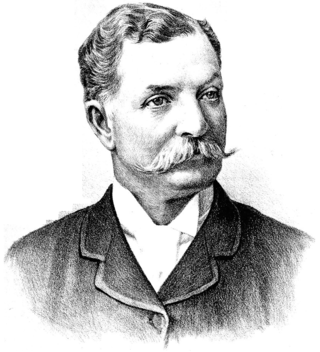
Sir Francis Bathurst Suttor was an Australian pastoralist, politician, and sheep and horse breeder.

Bourke was an electoral district of the Legislative Assembly in the Australian state of New South Wales from 1880 to 1904, including the towns of Bourke and Cobar. It elected two members simultaneously between 1882 and 1889 increasing to three members until 1894, with each elector being able to vote for as many candidates as there were vacancies.

Sir Joseph Palmer Abbott, was an Australian politician, pastoralist and solicitor.
William Love (1810-1885) was a member of the New South Wales Legislative Assembly for West Sydney from 1860 to 1864. Love served as Chairman of the Sydney Revenues Improvement Bill Committee.
Members of the New South Wales Legislative Assembly who served in the 11th parliament of New South Wales held their seats from 1882 to 1885. Elections for the eleventh Legislative Assembly were held between 30 November and 21 December 1882 with parliament first meeting on 3 January 1883. The Assembly was expanded to 113 members elected in 40 single member electorates, 26 two member electorates, 3 three member electorate and 3 four member electorates. The parliament had a maximum term of 3 years and was dissolved on 7 October 1885 after 33 months. The Premiers during this parliament were Sir Alexander Stuart until 7 October 1885 and then George Dibbs. The Speaker was Edmund Barton.

James Henry Young was an Australian colonial businessman and politician and Speaker of the New South Wales Legislative Assembly.

The fifth Parkes ministry was the 26th ministry of the Colony of New South Wales, and was led by the seventh Premier, Sir Henry Parkes. It was the fifth and final occasion that Parkes was Premier. The title of Premier was widely used to refer to the Leader of Government, but was not a formal position in the government until 1920. Instead the Premier was appointed to another portfolio, usually Colonial Secretary. Having served in the New South Wales Legislative Council between 1854 and 1856, Parkes was elected in the first free elections for the New South Wales Legislative Assembly held in 1856, however resigned from Parliament later that year. He served in the Assembly on several occasions, between 1858 and 1870, being forced to resign on 4 occasions due to his personal insolvency. He came to power as Premier on the first occasion in 1872, serving as Premier for a period of three years. However, Parkes lost the confidence of the Assembly following Governor Robinson's decision to release of the bushranger Frank Gardiner led to the defeat of the ministry in 1875.

The second Dibbs ministry was the 25th ministry of the Colony of New South Wales, and was the second of three occasions of being led by the tenth Premier, George Dibbs. Dibbs was elected to the New South Wales Legislative Assembly in 1874. In a period of great financial stress for the Colony, this ministry covers just 49 days from 17 January 1889 until 7 March 1889. Dibbs took over as Premier on the first occasion in October 1885 following resignation of the Alexander Stuart due to ill-health, with his ministry lasting for 75 days. Dibbs served as Colonial Secretary in the Jennings ministry, before it too suffered budgetary pressures. It was during this time that the party system was formed in New South Wales with Sir Henry Parkes leading the Free Trade Party. Dibbs had been elected as an independent free trader, however his opposition to Parkes caused Dibbs to align himself with the Protectionist Party. Dibbs had assumed office when Parkes lost a vote on the floor of the Assembly. Parliament was dissolved on 19 January 1889 and an election was held in February. There was a significant swing to the Protectionists, gaining 29 seats, however it was insufficient to command a majority of the Legislative Assembly and Parkes resumed the premiership.
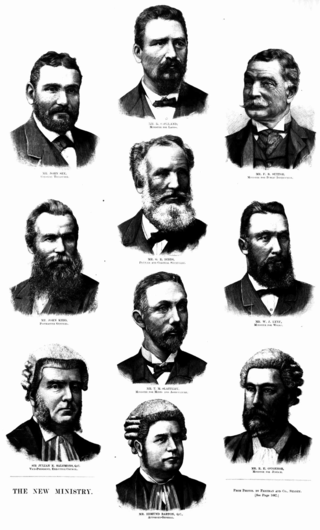
The third Dibbs ministry, the 27th ministry of the Colony of New South Wales, was led by Sir George Dibbs, leader of the Protectionist Party, following the 1891 New South Wales election, which saw the Labour Party win seats in the New South Wales Legislative Assembly and the balance of power. With no party having a majority, Sir Henry Parkes held on as Premier until October 1891 when he lost a vote in the Legislative Assembly, causing Parkes to resign as Premier and leader of the Free Trade Party. Dibbs formed the ministry on 23 October 1891, with Labour support, and comprised 10 ministers.
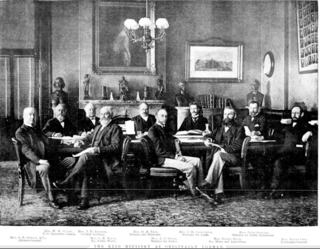
The Reid ministry was the 28th ministry of the Colony of New South Wales, and was led by the 12th Premier, George Reid. The title of Premier was widely used to refer to the Leader of Government, but was not a formal position in the government until 1920. Instead the Premier was appointed to another portfolio, usually Colonial Secretary but on this occasion Reid took the portfolio of Colonial Treasurer until July 1899 and then Attorney General.
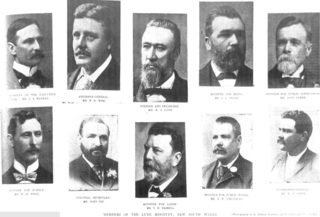
The Lyne ministry was the 29th ministry of the Colony of New South Wales, and was led by the 13th Premier, Sir William Lyne, KCMG.

The See ministry was the 30th ministry of the New South Wales Government, and was led by the 14th Premier, Sir John See. The title of Premier was widely used to refer to the Leader of Government, but was not a formal position in the government until 1920. Instead the Premier was appointed to another portfolio, usually Colonial Secretary.
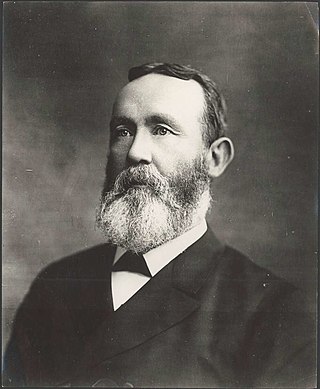
Francis Augustus Wright was a merchant sailor, gold miner, carrier and member of the Parliament of New South Wales.
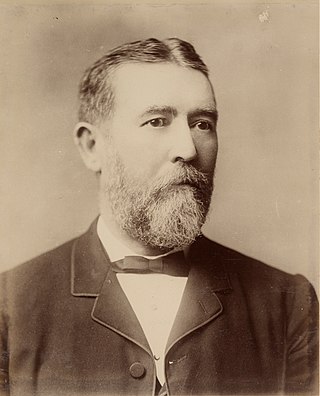
James Watson was an Australian politician, Colonial Treasurer of New South Wales 1878 to 1883.
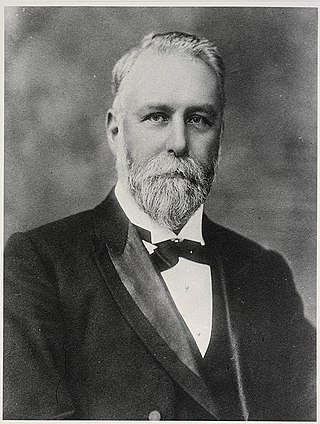
Louis Francis Heydon was a politician and solicitor in New South Wales, Australia and was Minister of Justice for six weeks 1885 to 1886.

Sir John Lackey was a magistrate and politician in colonial New South Wales, President of the New South Wales Legislative Council 1892 to 1903.

Charles Gilbert Heydon was an Australian politician and judge.
A by-election was held for the New South Wales Legislative Assembly electorate of East Sydney on 7 November 1891 because Edmund Barton (Protectionist) was appointed Attorney General in the third Dibbs ministry. Such ministerial by-elections were usually uncontested and the other seven other ministers, George Dibbs, Henry Copeland, John Kidd (Camden), William Lyne, John See (Grafton), Thomas Slattery (Boorowa) and Francis Suttor (Bathurst), were re-elected unopposed.
A by-election was held for the New South Wales Legislative Assembly electorate of Gundagai on 21 November 1884 because of the resignation of Bruce Smith, to return to Melbourne to run his father's business, WM Howard Smith and Sons Ltd.